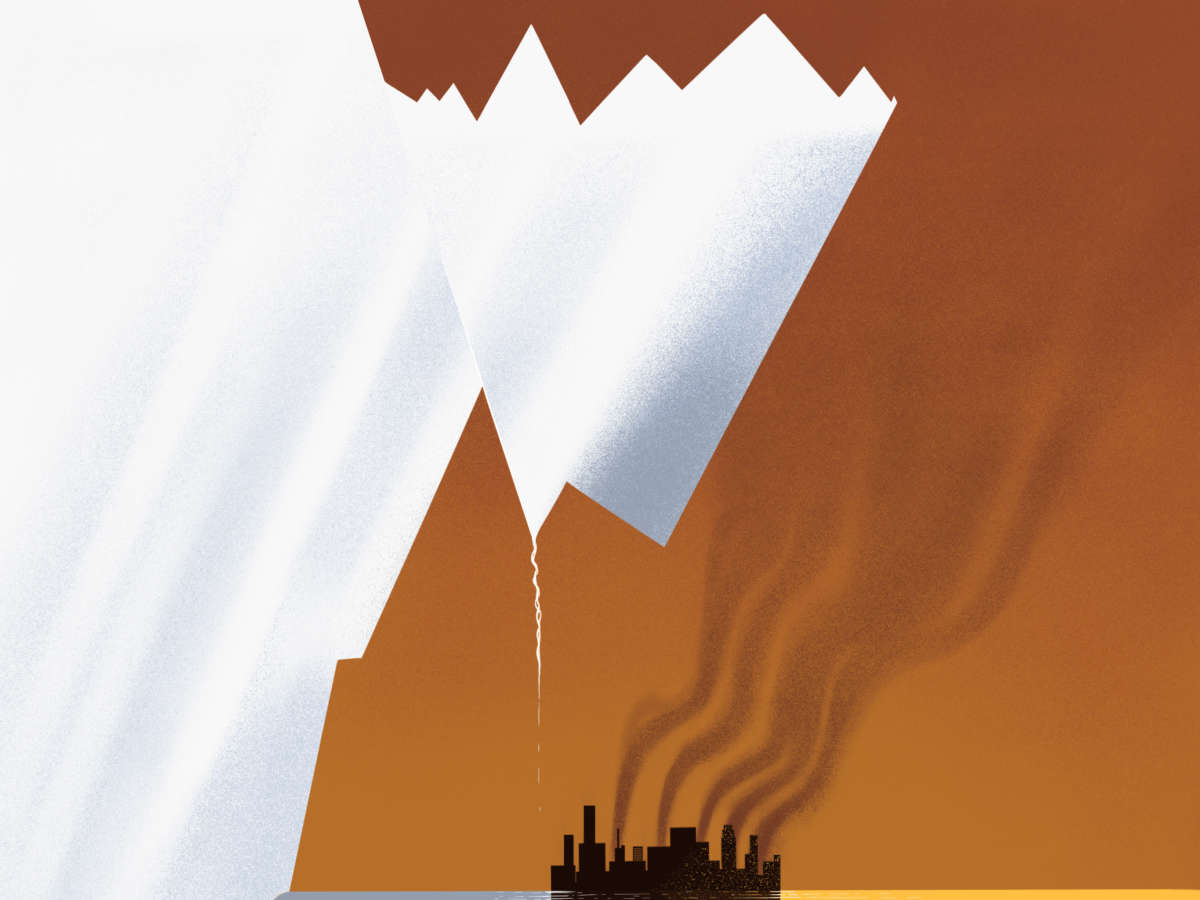
It was an “instant classic” viral video. A hiker enjoying a guided trip in the Tian Shan Mountains of Kyrgyzstan pulled out his cellphone and captured the sectional collapse of, and ensuing avalanche from, an enormous glacier. Much like a horror movie, the suspense builds as the massive, billowing wall of ice, rocks and debris moves ever closer to the hiker, Harry Shimmin of the U.K., whose steady hand maintains the crystal-clear picture on his phone.
Ultimately, the avalanche bears down on Shimmin, who acted like a voyeur watching a dangerous drama in which he actually had a starring role. At the last minute, and after a couple of “Oh, dear Gods,” he hastily dropped behind a rock as the barrage unleashed by the climate-afflicted glacier began pelting him and the group of hikers travelling with him. Luckily, they all survived.
Simultaneously exciting and terrifying, Shimmin’s video affords us all a rare glimpse of the unstoppable power of a collapsing glacier. At least, it used to be rare. Just about a week earlier in the Dolomite Mountains of northeastern Italy, 11 hikers were killed when a breakaway chunk of the Marmolada Glacier unleashed a similar onslaught. Not coincidentally, this occurred during a “record-breaking heat wave during the country’s worst drought in 70 years,” which has deprived the mountains of winter snow. The drought is also depriving the Po River Valley of the water it needs to produce the olive oil and world-renowned risotto rice that makes it among the world’s most storied agricultural regions.
In years past, the Po River Valley could depend on the run-off from countless tons of snow in the Cottian Alps, where the mountainous borders of Italy and France meet. However, now it’s gotten so dire in the Alps that the Swiss are now covering up their iconic ice with expensive UV-resistant “geotextile” blankets. It’s a desperate bid to slow what is increasingly inevitable. One prediction is that all of the mountainous nations’ glaciers could be gone by the turn of the next century. In 2021, a Swiss ski resort essentially put a band aid on this broken leg by throwing 1 million square feet of “giant fleece blankets” over a titanic glacier on Mount Titlis. Meanwhile, in the French Alps, the Tignes ski resort closed its summer glacier skiing season “a month earlier than scheduled,” truncating what used to be a summer continuation of skiing to just 14 days, the shortest in the history of the resort.
Across the English Channel, an epic heat wave sent parts of the U.K. over the 40 degrees Celsius (104 degrees Fahrenheit) mark for the first time in recorded history. The “heat apocalypse” stoked destructive flames along a wildfire-scarred swath of southern Europe stretching from Portugal to Greece. According to The Independent, those fires produced an estimated “11 million tonnes of planet-heating emissions.” The recent trend of European heat waves is also stoking fears of more glacial disasters. The continent’s glaciers are melting “faster than ever,” and, as AP News reported, a satellite assessment in 2021 (that’s before this year’s historic heat wave) found that glaciers are “losing 31% more snow and ice per year than they did 15 years earlier.”
And that’s just the tip of the iceberg.
On February 7, 2021, a wedge of glacier-covered rock more than 500 meters wide and 180 meters thick just “suddenly let go” in the Himalayas and, as BBC News reported in June of that year, a mixture of rock, ice and water hit the valley floor below “like 15 atomic bombs.” Over 200 people living and working in the Chamoli district of the Indian state of Uttarakhand were killed and hydroelectric infrastructure worth hundreds of millions of dollars was lost in the deluge. Although scientists are careful to not overplay climate change as the direct cause, researchers did write that “glacier shrinkage uncovers and destabilises mountain flanks and strongly alters the hydrological and thermal regimes of the underlying rock.” Sadly, the mountainous state was hit again on April 23, 2021, when a glacier “burst” sparked an avalanche in Sumna, this time killing 16 near the Indo-China border.
Just a month later, on May 20, a chunk of Antarctic ice reportedly “three times the size of New Delhi” broke free and set sail on the sweltering seas. Dubbed “A-76” by scientists, the “world’s largest iceberg” is destined to methodically melt like another viral sensation, an earlier breakaway iceberg known as “A-68.” Then it happened again. In November, a huge hunk of the Perito Moreno Glacier fell into the waters abutting Los Glaciares National Park in Argentina’s “fast melting” Patagonia region. It was much to the amazement of “stunned” onlookers who, like Harry Shimmin, found themselves bearing witness to the fallout of anthropogenic climate change while on holiday.We’ve basically doubled-down on carbon emissions after the over-hyped carbon interregnum during the pandemic.
But it doesn’t end there.
On March 5, 2022, another group of tourists in Argentina “oohed and ahhed” when a glacier broke off of a 60-meter-high cliff, plunged and then re-emerged from the sea. Twenty-one days later, an “ice shelf bigger than New York City” broke off in an area in eastern Antarctica that scientists have, according to The Washington Post, thought to be “relatively stable and far less vulnerable to global warming compared to ice in western Antarctica.” Ominously, a trio of scientists observed that “there is enough ice in the West Antarctic ice sheet to raise sea levels by several meters, and if East Antarctica starts losing significant amounts of ice, the impact on sea levels could be measured in tens of meters.”
As the great science journalist Robert Krulwich recently explained in a superb animated video for CBS “Sunday Morning,” the last time atmospheric CO2 concentrations were this high was 2.5 million years ago. Known as the Pliocene Era, the Earth was “about 3 or 4 degrees” (Celsius) warmer and global sea levels were 55 feet higher than they are today. That’s right … 55!
Is that what’s in store for us over the next century should we continue to burn hydrocarbons like there’s no tomorrow? We certainly seem hell-bent on finding out, because we’ve basically doubled-down on carbon emissions after the over-hyped carbon interregnum during the pandemic. And if our Anthropocene Era sees only half of the Pliocene sea level rise, there will, in fact, be no tomorrow for millions, if not billions of humans crowded along the Earth’s coasts or living downstream from the world’s melting glaciers. It promises to be the greatest disaster humans have ever produced. But just like Shimmin, we can’t say we didn’t see it coming.
Hell, we can even see it from space.
Satellite images from the European Union’s Earth observation program show how drastically the aforementioned Po River has changed over the last two years. They named the satellite “Copernicus” in honor of the Renaissance genius who challenged centuries of church canon by proving the Earth, and by extension humankind, was not at the center of the universe, but rather it (and humans) revolved around the Sun.
Now Copernicus revolves around the Earth, revealing, as Euronews reported, the stark impact we’re having on this staggeringly rare harbor for life in, as far as we’ve found, an otherwise life-averse solar system. In the Po Valley, it shows exposed sand where water once ran and, in turn, helped sustain 125 municipalities and numerous farms that are now forced into rationing.
Satellite data collected by NASA in early July of this year showed similarly parched areas of the Great Salt Lake in Utah, which is increasingly bereft of its famously briny waters. In fact, it now sits at its “lowest level in 175 years of record keeping,” according to Discover Magazine, which paired the satellite images with photos illustrating how a dire, regional drought is currently damaging the lake.
The once-greater lake’s salty sister in California is suffering a similar retreat. Mono Lake was famously brought back from the brink by an incredibly effective citizen-led campaign in the 1970s, ‘80s and ‘90s. But now, its once-ubiquitous “Save Mono Lake” bumper stickers have long-since faded and the lake is again endangered. This time, it’s not the excessive redirection of its tributary waters to quench the thirst of millions of Southern Californians. Water is still pulled, but now Mono Lake, like all the examples in this sad litany, is also battling a drought made more disastrous by a “two-decade run of extreme warming and drying.”
Approximately 350 miles southwest of Mono Lake, we find Lake Mead, which stands at its lowest level since the human-made reservoir was first filled in 1937. It is nearing the nadir of a “22-year downward trend.” That’s per scientists at NASA’s Earth Observatory, which recently released a shocking set of satellite photos showing the lake literally drying-up in three stages since the year 2000. You may have seen ‘em, because the photos had a viral moment as they made the rounds on social media, like the media of avalanches and floods and cattle dropping dead before it. Lake Mead had already made the news repeatedly, particularly as the receding waters exposed possible murder victims. What’s not a mystery is what’s killing the “largest reservoir in the United States,” which, as NASA notes, supplies water to “millions of people across seven states, tribal lands, and northern Mexico,” but is currently “filled to just 27 percent of capacity.”There’s little doubt that the commonality of pools and second cars in sun-baked desert metropolises like Las Vegas and Phoenix [stokes] the climate feedback loop driving the drought.
The irony is that its closest customer, Las Vegas, the home of unbridled excess, has a surprisingly low draw from Mead and an efficient system that captures, treats and returns water to the lake. Still, Southern Nevada gets 90 percent of its water from the drought-ravaged Colorado River via Lake Mead, and, as AP News reported, it’s still home to 200,000 swimming pools, with 1,300 more pools added annually. It’s also home to an estimated 3,000 “commercial” pools that serve 40 million tourists who fly and drive to Las Vegas every year. Unsurprisingly, those commercial pools are not affected by new water restrictions. One critic of the restrictions, who happens to own a custom pool design business, said without irony, “When you’re in the desert and it’s 100 degrees outside on a regular basis, it’s part of life to have a pool,” and “having a pool in Las Vegas is like having a second car … it’s that common.”
Alas, pools and second cars in sun-baked desert metropolises like Las Vegas and Phoenix (with the most pools per capita) are local cogs in a globe-spanning, fossil-fueled economic machine that’s driving the climate feedback loop now threatening the river that helps to fill those ubiquitous pools. The same goes for using air conditioning to survive a superheating world, which pumps out CO2 and further heats the world, thus making air conditioning even more necessary and, in turn, accelerating the heating that melts glaciers and dries up lakes and ignites wildfires in rapidly escalating doom-loop.
This escalating feedback loop is also responsible for the suffering of more than 2 billion people currently sweltering in India, Pakistan and China, for impoverished climate refugees fleeing from Central America, and for millions of low-carbon-producing, sea-level Bangladeshis inauspiciously stuck between collapsing glaciers in the Himalayas and melting breakaway ice shelves now bobbing in the warming oceans.
But the time when we can sit back and marvel at these climate catastrophes is as long gone as Iceberg A-68. Now the viral moments are much closer to home … from Kansas to Kentucky, from Nebraska to Texas and Maine, and we are all more and more like Harry Shimmin with each passing day as the reality of climate change becomes as relentless as a collapsing glacier. Earth’s climate is breaking through the fourth wall to show us that we cannot afford the luxury of voyeurism.
In essence, Mother Nature’s “invisible hand” is imposing punishment on an economic system that pretends we can sustain unlimited growth on a planet of limited resources and, astonishingly, somehow remain free of the feedback loop’s environmental consequences. In fact, that’s what Mother Nature is telling us in these viral moments. Her invisible hand is enforcing a brutal type of ecological discipline on an economic system that is divorced from reality.
Breaking the feedback loop is really the only option we have left.
JP Sottile is a freelance journalist, published historian, radio co-host and documentary filmmaker (The Warning, 2008). His credits include a stint on the “NewsHour” news desk, C-SPAN and as newsmagazine producer for ABC affiliate WJLA in Washington. His weekly show, “Inside the Headlines With The Newsvandal,” co-hosted by James Moore, airs every Friday on KRUU-FM in Fairfield, Iowa. He blogs under the pseudonym “The Newsvandal.”
MORE BY THIS AUTHOR…








